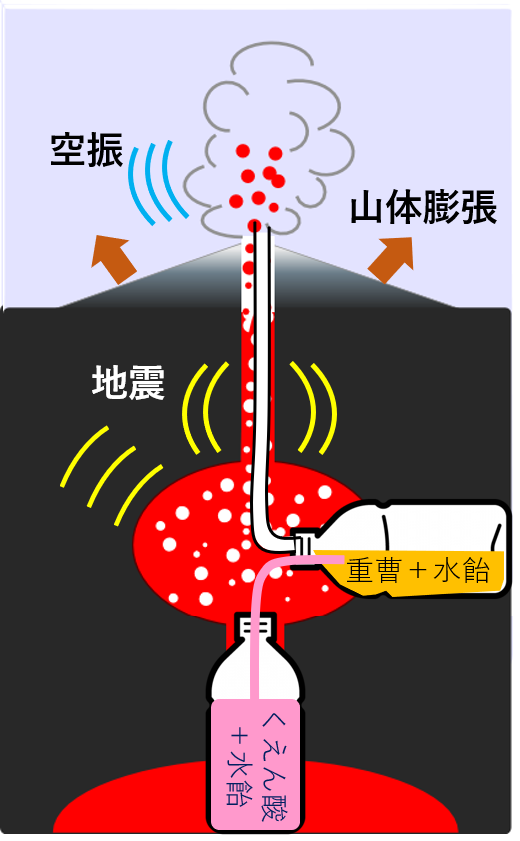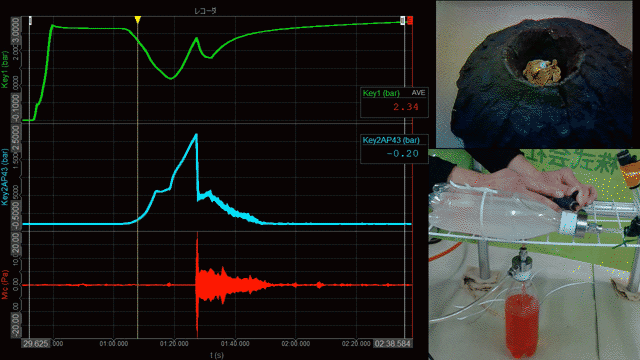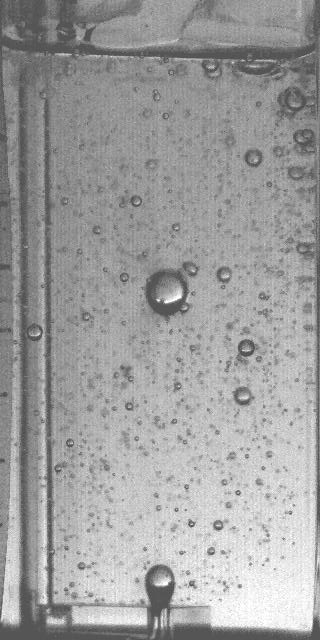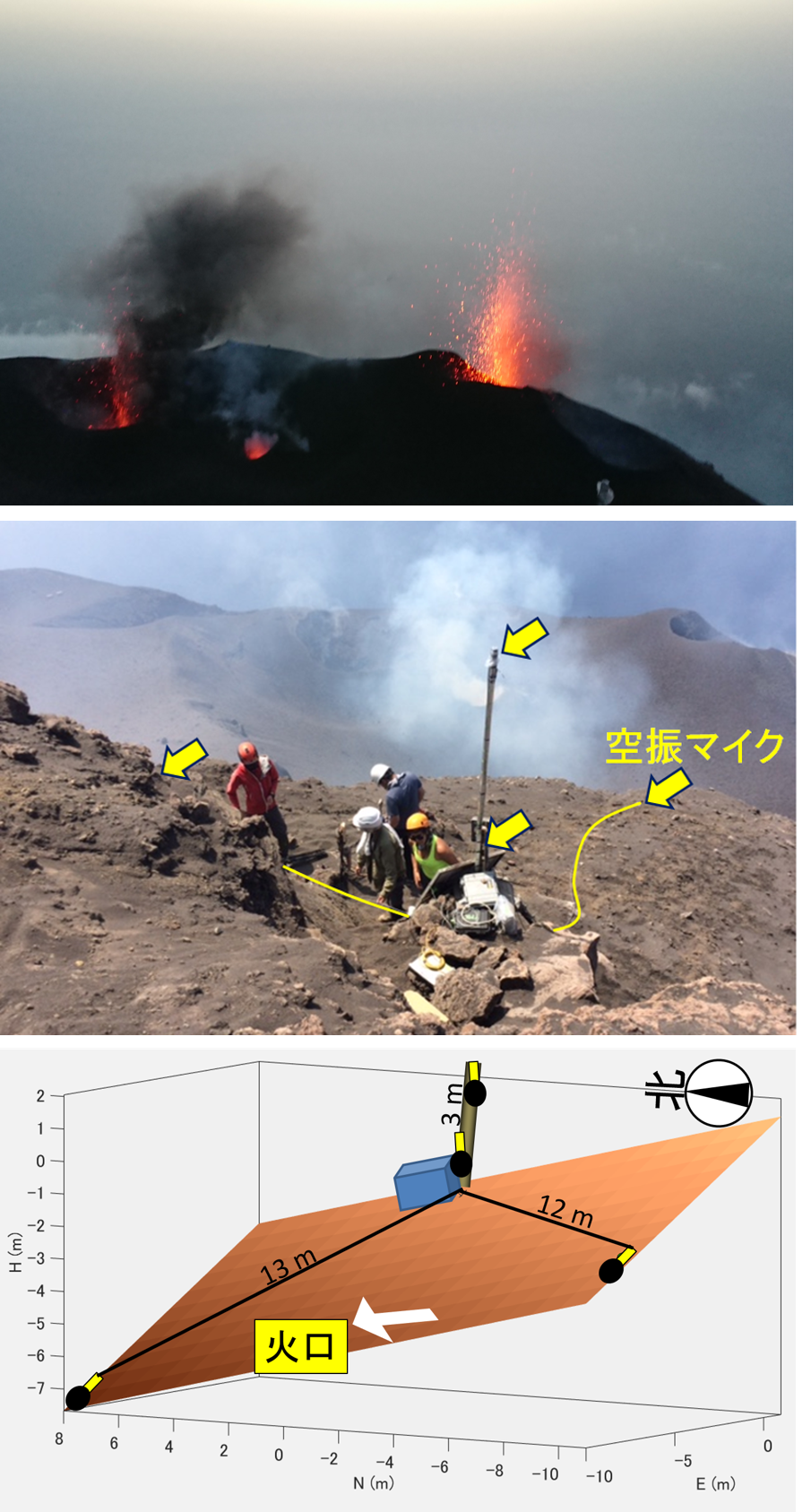Research Topics
Research introduction pamphlets for each academic year can be found here.
-
Academic Year 2023 Academic Year 2019 Academic Year 2018 Academic Year 2017 Academic Year 2016 Academic Year 2015 Academic Year 2014
Past Research Topics2014-2019
Master's and Doctoral Theses of Graduates
Introduction
Volcanic eruption mechanisms and the associated wave phenomena are the main focus of our laboratory’s research. Volcanic eruptions can essentially be understood as thermodynamic phenomena; however, magma exhibits properties that transition between fluid and solid states. While 'solid flow' is a significant topic in solid Earth sciences, such as mantle convection, in volcanoes, the issue lies in 'fluid fracture.' We have been studying the nature of this process through theoretical and experimental approaches. In addition, various vibrational phenomena are observed in active volcanoes, manifesting as seismic activity, ground deformation, and airwaves (sound waves). Even when, in our daily lives, we can interpret a wide range of information from sounds, our ability to 'listen' to volcanic reverberations is still poorly developed. By observing volcanic ‘sounds’ in the field and conducting model experiments, we are attempting to understand the meaning of these vibrations.
Volcanic eruption simulation experiment and understanding pressure variations
 Volcanic eruptions are driven by the expansion and foaming of gases dissolved in magma. One proposed mechanism leading to eruptions is the mixing of magmas with different temperatures and compositions underground. To deepen our understanding of this process and the phenomena associated with it, as well as to provide a widely accessible educational tool, we conduct volcanic eruption simulation experiments using plastic bottles. In these experiments, we mix syrup containing citric acid with syrup containing baking soda, triggering foaming through a chemical reaction.
Volcanic eruptions are driven by the expansion and foaming of gases dissolved in magma. One proposed mechanism leading to eruptions is the mixing of magmas with different temperatures and compositions underground. To deepen our understanding of this process and the phenomena associated with it, as well as to provide a widely accessible educational tool, we conduct volcanic eruption simulation experiments using plastic bottles. In these experiments, we mix syrup containing citric acid with syrup containing baking soda, triggering foaming through a chemical reaction.
The video below shows the results of an experimental lecture held at Kyushu University as part of the Next Generation Volcano Researchers Training Program. In the experiment, we measured pressure changes in both a deep magma chamber and a shallow magma chamber (represented by the green and light blue lines, respectively), as well as acoustic waves at the surface (represented by the red line), alongside visual imagery. The pressure changes correspond to observations of crustal deformation, while the acoustic waves relate to airwave observations. This experiment allows us to observe the state of magma chambers and volcanic conduits, which are not visible in actual volcanoes, sparking imagination and curiosity. Even with simple experiments, changing the initial conditions reveal various eruption types and fluctuations, highlighting that our understanding and control of these processes are still incomplete.

Here for more eruption experiment videos.
Fluid fracture experiments to understand the mechanism of magma fracture and air vibration generation
 Magma is molten rock, exhibiting both liquid and solid properties. This duality means that if a sudden force is applied, magma can shatter into fragments, much like glass. Such explosive fragmentation causes significant dangers. If magma consistently behaved like glass, volcanic eruptions would be far more violent and hazardous.
In reality, magma often exists in an intermediate state between liquid and solid. However, the mechanisms by which such “intermediate substance” breaks apart and the physical properties governing these processes remain poorly understood.
Our research group explores the complex physical properties of magma by conducting deformation and fracture experiments using fluids that mimic its characteristics. The video on the left demonstrates an experiment in which bubbles are injected into a soft, jelly-like substance possessing both viscosity and elasticity. To visualize elastic deformation, the property of photoelasticity was used.
While these experiments cannot be directly applied to magma, they help us gain a deeper understanding of the physics underlying these phenomena and contribute to the development of more sophisticated models of volcanic processes. (Sanchez)
Magma is molten rock, exhibiting both liquid and solid properties. This duality means that if a sudden force is applied, magma can shatter into fragments, much like glass. Such explosive fragmentation causes significant dangers. If magma consistently behaved like glass, volcanic eruptions would be far more violent and hazardous.
In reality, magma often exists in an intermediate state between liquid and solid. However, the mechanisms by which such “intermediate substance” breaks apart and the physical properties governing these processes remain poorly understood.
Our research group explores the complex physical properties of magma by conducting deformation and fracture experiments using fluids that mimic its characteristics. The video on the left demonstrates an experiment in which bubbles are injected into a soft, jelly-like substance possessing both viscosity and elasticity. To visualize elastic deformation, the property of photoelasticity was used.
While these experiments cannot be directly applied to magma, they help us gain a deeper understanding of the physics underlying these phenomena and contribute to the development of more sophisticated models of volcanic processes. (Sanchez)
Eruption observation using a ultra-small infrasound temporary array
 Air vibrations are low-frequency sound waves that are inaudible to the human ear. Occasionally, strong airwaves occur that can be felt physically or even break window glass. However, in most cases, even when examining data measured by sensors, it is difficult to clearly identify the waveforms or pinpoint their onset. On the other hand, understanding when, where, and how the airwaves occurred is crucial for effectively grasping the starting point and progression of an eruption.
Air vibrations are low-frequency sound waves that are inaudible to the human ear. Occasionally, strong airwaves occur that can be felt physically or even break window glass. However, in most cases, even when examining data measured by sensors, it is difficult to clearly identify the waveforms or pinpoint their onset. On the other hand, understanding when, where, and how the airwaves occurred is crucial for effectively grasping the starting point and progression of an eruption.
The direction of a sound source can be estimated using an observation and analysis method called an 'array,' which involves measuring sound waves with multiple sensors arranged in a specific pattern. Conventional air vibration arrays used sensors spaced approximately 100 meters apart, which made installation and maintenance challenging. However, using the latest sensors, we demonstrated that sound source direction can be determined with sufficient accuracy even with sensors spaced just 10 meters apart. Additionally, we found that arranging sensors in a slightly three-dimensional configuration significantly improves the accuracy of height estimation for the sound source.
The figure on the left shows an example of a miniature air array deployed at Stromboli Volcano in Italy. This method has also been applied to volcano observations at Sakurajima and Kirishima, as well as avalanche monitoring at Mt. Fuji.(Yamakawa/Ikeda)